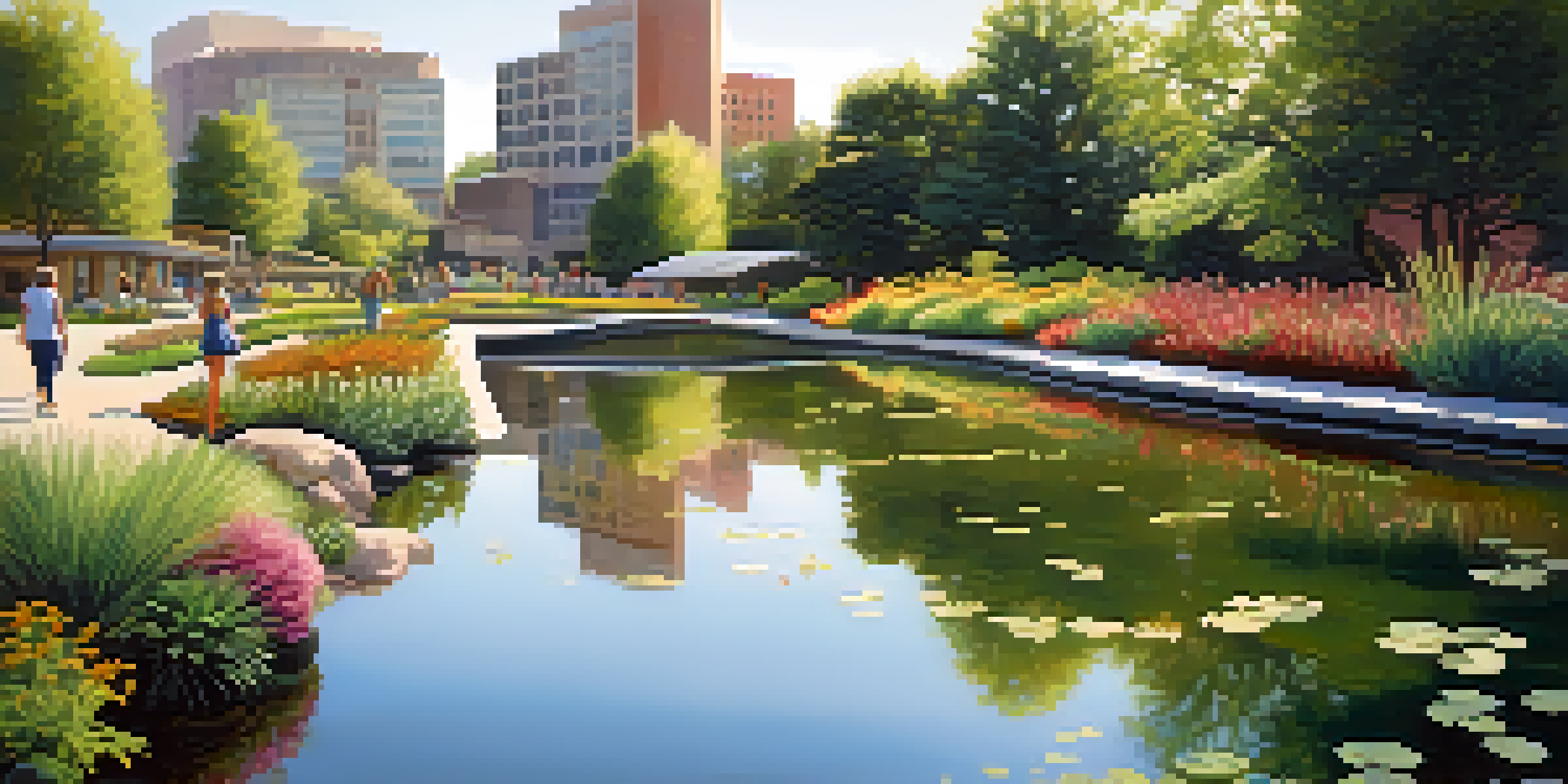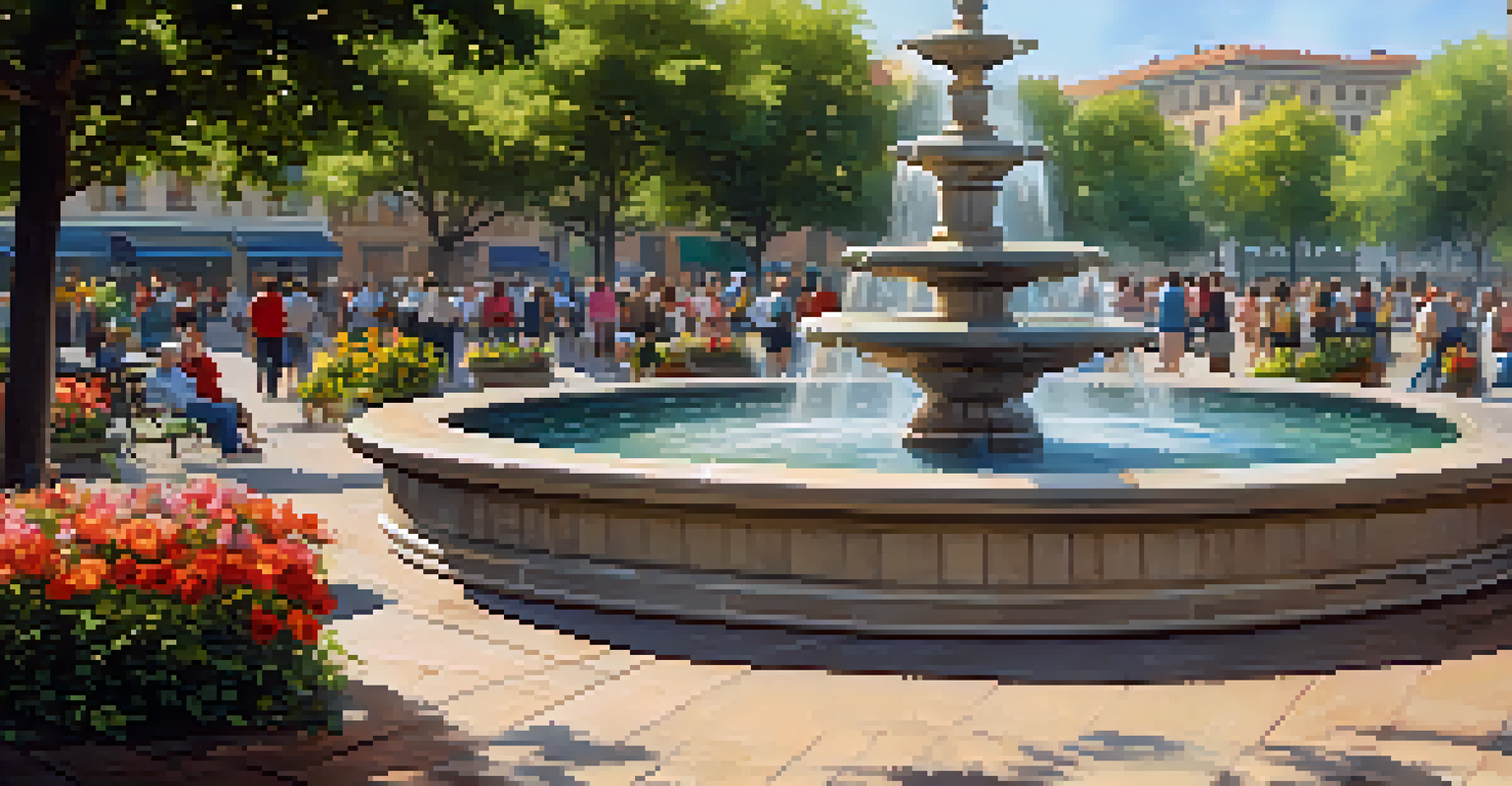Integrating Water Features in Sustainable Architectural Design

The Role of Water in Sustainable Architecture
Water is a vital element in sustainable architectural design, offering not just aesthetic appeal but also functional benefits. Incorporating water features can help manage stormwater, reduce urban heat, and improve air quality. For instance, a well-designed water garden can naturally filter pollutants, contributing to a healthier environment.
Water is the driving force of all nature.
Incorporating water into buildings can also create microclimates, providing cooler areas in hot climates. This not only enhances comfort for occupants but also reduces reliance on energy-consuming cooling systems. Additionally, the sound of flowing water can promote relaxation and well-being, making spaces more inviting.
Moreover, water features can serve educational purposes, raising awareness about water conservation and ecological balance. By showcasing sustainable practices, architects can inspire communities to engage in environmental stewardship, ultimately contributing to a more sustainable future.
Types of Water Features in Architecture
There are several types of water features that can be integrated into architectural designs, each serving unique purposes. Ponds and lakes can provide habitat for wildlife, while fountains and streams can enhance aesthetic appeal and auditory experiences. Rooftop gardens with water elements also offer a green respite in urban settings, blending nature with architecture.

Rainwater harvesting systems are another innovative way to incorporate water features sustainably. These systems can collect and store rainwater for irrigation or toilet flushing, thus reducing the demand on municipal water supplies. This not only conserves water but also can create beautiful reflective pools that enhance the overall design.
Water Features Enhance Sustainability
Incorporating water features into architectural designs helps manage stormwater, improve air quality, and foster biodiversity.
Interactive water features, like splash pads or misting systems, engage users and provide a playful element to public spaces. They not only cool the air but also invite social interactions, making them valuable additions to community parks and plazas.
Benefits of Water Features for Biodiversity
Integrating water features into architectural design significantly boosts biodiversity in urban areas. These features can create habitats for various species, including birds, insects, and aquatic life. For example, a small pond can attract frogs and dragonflies, playing a crucial role in maintaining local ecosystems.
We forget that the water cycle and the life cycle are one.
Moreover, water features can promote biodiversity by improving soil quality and supporting plant growth. The moisture provided by these features allows for a wider variety of plant species to thrive, creating a more diverse landscape. This, in turn, enhances the aesthetic value of the area and contributes to overall ecological health.
By fostering habitats within urban environments, architects and designers can help combat the impacts of urbanization. This approach not only enriches our surroundings but also builds resilience against climate change by supporting diverse ecosystems.
Water Conservation Strategies in Design
Sustainable architectural design emphasizes the importance of water conservation, and water features can play a pivotal role in this effort. Techniques such as xeriscaping, which involves using drought-resistant plants, can reduce water usage significantly. When paired with water features, these landscapes can create a harmonious balance between beauty and conservation.
Implementing greywater recycling systems is another effective strategy. These systems reuse water from sinks and showers for irrigation or flushing toilets, reducing overall water consumption. By integrating these systems with water features, architects can create a closed-loop system that maximizes efficiency.
Aesthetic and Functional Benefits
Water features not only serve practical purposes but also create visually appealing spaces that promote relaxation and well-being.
Smart irrigation systems that adjust watering schedules based on weather conditions can also enhance water conservation. By utilizing sensors and timers, these systems ensure that water is used judiciously, further supporting sustainable practices in architectural design.
Creating Aesthetic and Functional Spaces
Water features not only serve functional roles but also enhance the aesthetic quality of architectural designs. A tranquil pond or an elegant fountain can act as a focal point, drawing people in and creating a sense of place. This aesthetic appeal can elevate the overall experience of both residents and visitors.
Moreover, the integration of water features can provide a sense of tranquility and relaxation. The visual and auditory aspects of flowing water can reduce stress and promote well-being, making spaces more enjoyable. This emotional connection to nature is especially important in urban environments where green spaces may be limited.
By thoughtfully designing water features, architects can create spaces that are both beautiful and beneficial. This duality not only enriches the environment but also encourages people to engage with their surroundings in a meaningful way.
Challenges in Integrating Water Features
While the benefits of water features are numerous, there are also challenges to consider during the design process. One major challenge is ensuring that the water systems remain sustainable and require minimal maintenance. Proper planning and design can help mitigate issues such as algae growth and water stagnation.
Another challenge is the cost associated with installation and maintenance. While water features can enhance property value, initial investments can be significant. However, it's essential to view this as a long-term investment in sustainability and quality of life.
Challenges and Future Innovations
While integrating water features presents challenges like maintenance and cost, future trends focus on sustainability and smart technology enhancements.
Additionally, water features must be designed with local climate conditions in mind. For instance, in arid regions, water conservation strategies must be prioritized to ensure that these features do not become a liability. Balancing aesthetics, function, and sustainability requires careful consideration and expertise.
Future Trends in Water Feature Design
As sustainability becomes increasingly important in architectural design, the future of water features looks promising. Innovations such as biophilic design, which seeks to connect people with nature, are gaining traction. This approach emphasizes the integration of natural elements, including water, into built environments.
Smart technology is also making its way into water feature design, allowing for more efficient management. Automated systems can adjust water levels and quality, ensuring that the features remain healthy with minimal human intervention. This not only improves sustainability but also enhances the user experience.

Lastly, community involvement in the design process is becoming more prevalent. Engaging local communities in the planning and maintenance of water features can foster a sense of ownership and stewardship. This collaborative approach ensures that these features meet the needs of the community while promoting sustainability.